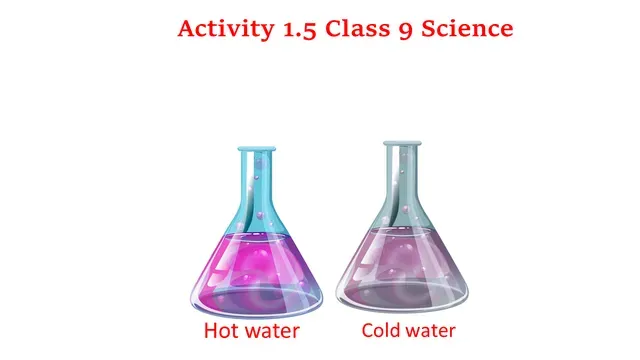In this post, you will find NCERT Science Class 9 Chapter 1 Activity solutions. In Class 9 science chapter 1 matter in our surroundings consists of NCERT Activity 1.5 Class 9 Science Explanation with a conclusion. you can also go through Class 9 Maths Chapter 6- Lines and Angles
NCERT Activity 1.5 Class 9 Science Explanation with a conclusion
You are suggested to study NCERT activity 1.5 class 9
science explanation with a conclusion so that you can attempt questions based on
the activity 1.5 class 9 science.
Activity 1.5 Class 9 Science
· Drop a crystal of copper sulphate or potassium permanganate into a glass of hot water and another containing cold water. Do not stir the solution.
· Allow the crystal to settle at the bottom.
· What do you observe just above the solid crystal in the glass?
· What happens as time passes?
· What does this suggest about the particles of solid and liquid?
· Does the rate of mixing change with temperature? Why and how?
Observation Activity 1.5 Class 9 Science
The crystal
KMnO4 moves down in both beakers. The purple colour of potassium permanganate
spreads in the water of both beakers as time passed.
The purple colour
spreads slowly in cold water but spreads quickly in hot water.
Explanation Activity 1.5 Class 9 Science
Particles of substances have kinetic energy. When
we heat a substance, the kinetic energy increases because attraction forces between
particles become weak due to heat.
So, in hot
water crystals dissolve quickly whereas dissolving slowly in cold water.
Conclusion Activity 1.5 Class 9 Science
We can conclude
that at a higher temperature, the particles of matter move faster and have more
kinetic energy.
We can check
this activity ourselves at home. Add some sugar to hot water and cold water and try to dissolve. We see
that sugar dissolves in hot water quickly but dissolves slowly in cold water.
Related Topics
1. Next Activity- Activity 1.6 Class 9 Science
2. Previous Activity - Activity 1.4 Class 9 Science




